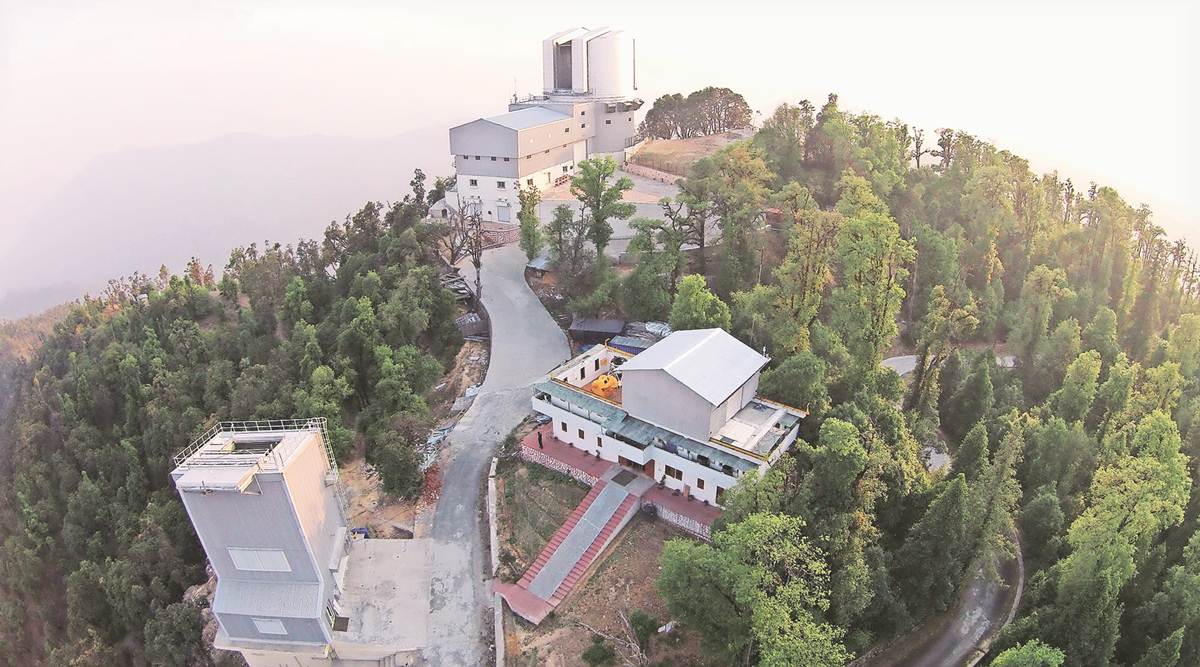 The Devasthal Observatory campus in Uttarakhand. ILMT is seen at the bottom left. (Image: ARIES)
The Devasthal Observatory campus in Uttarakhand. ILMT is seen at the bottom left. (Image: ARIES)India’s first liquid-mirror telescope, which will observe asteroids, supernovae, space debris and all other celestial objects from an altitude of 2,450 metres in the Himalayas, has seen its first light. It has now entered the commissioning phase and will start scientific observations some time in October this year.
Established on the campus of the Devasthal Observatory of the Aryabhatta Research Institute of Observational Sciences (ARIES) in Nainital, the International Liquid Mirror Telescope (ILMT) is the only liquid-mirror telescope operational anywhere in the world. It will also hold the unique tag of being the maiden liquid-telescope globally to be designed exclusively for astronomical purposes.
ILMT will be the third telescope to be operating from Devasthal after the 3.6-metre Devasthal Optical Telescope (DOT) — the largest in India commissioned in 2016 — and the 1.3-metre Devasthal Fast Optical Telescope (DFOT) inaugurated in 2010.
“Devasthal is considered as one of the best sites for astronomical observations,” Professor Dipankar Banerjee, director of ARIES, told The Indian Express on Thursday. This international telescope facility is the result of collaborative work between astronomers from ARIES, Institute of Astrophysics and Geophysics, Liège University, Belgium; the Canadian Astronomical Institutes from Vancouver, University of British Columbia; Laval University, University of Montreal, University of Toronto, University of Victoria, York University, Poznan Observatory, Poland, Ulugh Beg Astronomical Institute of Uzbek Academy of Sciences and the National University of Uzbekistan.
Best of Express Premium
The telescope was designed and built at the Advanced Mechanical and Optical Systems Corporation and the Centre Spatial de Liege, Belgium. The major instrumentation funding was jointly provided by Canada and Belgium while India will be responsible for the operations and upkeep of the telescope.
Only a handful of liquid-mirror telescopes have been previously built but were majorly used either for tracking satellites or for military purposes, said Dr Kuntal Misra, project investigator of ILMT at ARIES.
“Unlike the conventional telescopes that can be steered to track specific stellar source objects, the ILMT will be stationary. It will basically carry out observations and imaging at the zenith, that is, of the overhead sky. This is a survey telescope having high potential for discovering newer objects,” Misra said.
Over the past one month, all collaborators have been working in fine-tuning and setting up the operations of the ILMT before it is readied for full-scale scientific observations post the monsoon season.
And that is when humongous amounts of data will start coming-in, likely to keep the astronomers’ hands full.
“When the regular science operations begin, ILMT will produce about 10 GB of data / night, which will be quickly analysed to reveal variable and transient stellar sources,” said Dr Brajesh Kumar, ILMT Project Scientist and trained expert in handling liquid-mirror telescope operations.
The ILMT will operate every night for five years and carry out daily imaging except between June and August monsoon months, a precaution to protect the instruments from humid conditions.
“The ILMT data will be ideally suited to perform deep photometric and astrometric variability surveys over a period of five years,” Professor Jean Surdej, project director, University of Liège, Belgium, said.
With such large voluminous data soon to be generated, Banerjee said that the applications and algorithms using big data, Machine Learning (ML) and Artificial Intelligence (AI) will be implemented while classifying the celestial objects.
- The Indian Express website has been rated GREEN for its credibility and trustworthiness by Newsguard, a global service that rates news sources for their journalistic standards.

